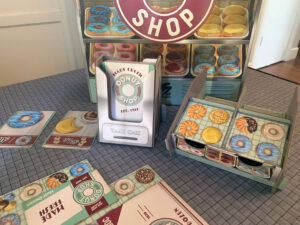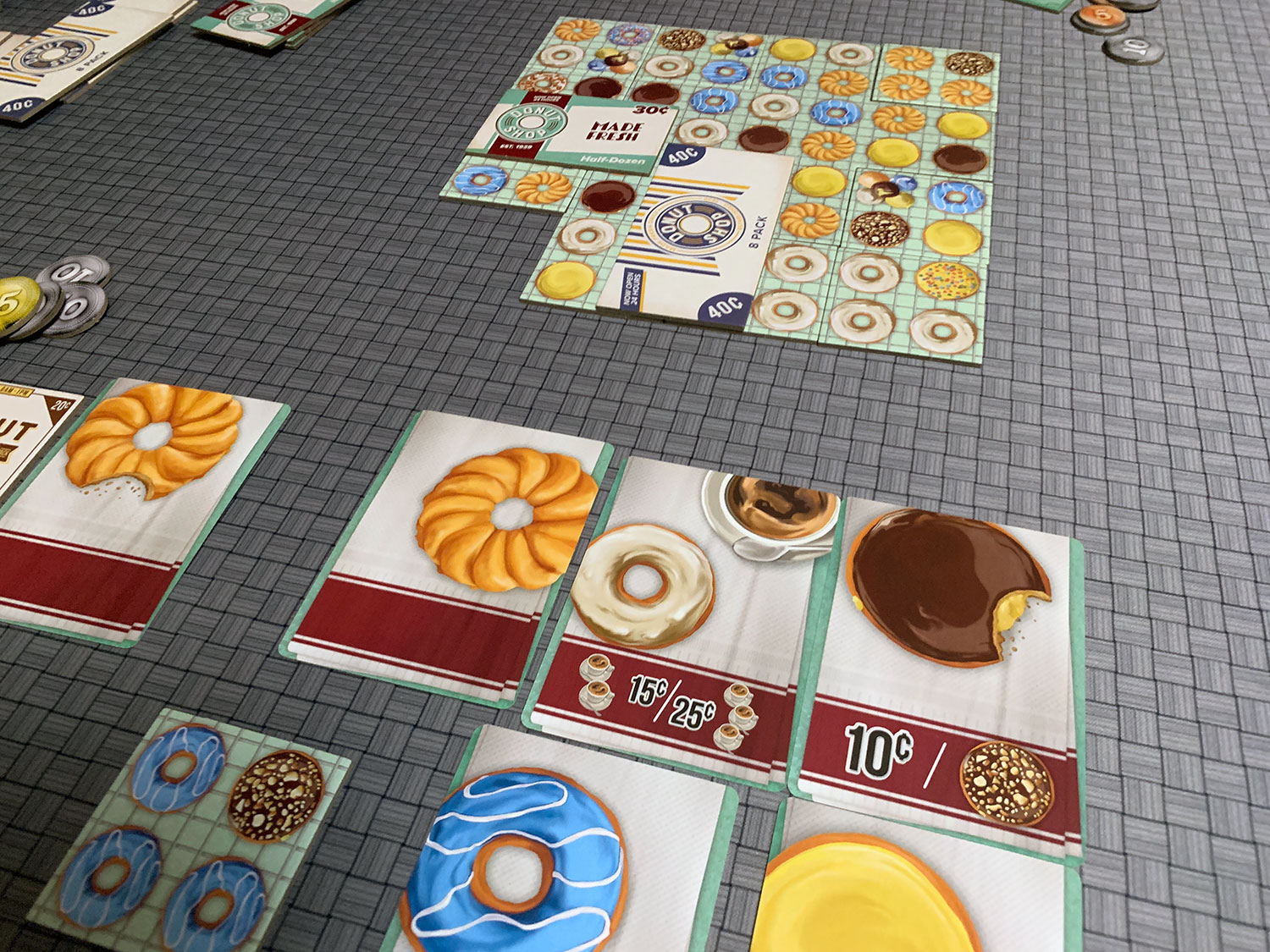 As a board game reviewer, I obviously like board games and will happily play them with people as often as possible. I also really like unhealthy foods like donuts as I picture fellow Board Game Quest reviewer/editor/healthier eater Chris groaning, “so many carbs…”.
As a board game reviewer, I obviously like board games and will happily play them with people as often as possible. I also really like unhealthy foods like donuts as I picture fellow Board Game Quest reviewer/editor/healthier eater Chris groaning, “so many carbs…”.
But don’t worry Krispy Kreme, Dunkin’, and Winchell’s. I’m here for you. I’m here for the carbohydrates in generic pink boxes as I review Donut Shop, a two to four player game by Jeffrey Allers that plays in 20 to 40 minutes for players ages 8 and up.
Gameplay Overview:
The goal of this game is to make the most money by placing matching donuts and filling orders. Tiles will be added to the display case which starts as a cross-shaped tile of donuts in the middle of the table.
A player’s turn plays out in four steps starting with playing the donut tile in your hand to the display case. The added tile must line up neatly where the edges of the tiles line up with other tiles, but donuts don’t have to match. Tiles also can’t be overlayed over other tiles as we’re trying to run a professional organization here.

Once a tile is placed, the player picks a donut type on it and earns 5 cents for each donut of that type on the tile placed and orthogonally contiguously connected to that tile. Donut holes are wild and extra features like sprinkles don’t change the donut type. Contiguous basically means all the matching donuts on all the tiles in both axial directions, which is more than continuous and could more easily be interrupted.
The third step is optional which is to box donuts up by placing one of the different-sized donut boxes over the display case. To box donuts, you need to cover donuts for which you have order cards. Some of these cards will grant bonuses for sprinkles, and coffee bonuses to earn even more money.
The fourth step is to pick either one of the exposed donut tiles or order cards. Whichever you take, you take a face down of the other type.
Players take turns until there are no more order cards or donut tiles in the drawstacks then each player gets one last turn but skips the last step. The player with the most money at the end is the winner.

Game Experience:
I shouldn’t have started a diet before reviewing this game because now I want a donut.
Donut Shop is a game that, despite what appears to be a very limited decision space each turn, is a very thinky game for its weight class. There are both short term tactical decisions and long term strategic decisions about placing donuts, which is a sentence I never expected to write. Additionally, the choice between taking a face up tile or face up card is a clever way to make people choose between available information.

Personally, I found if I was working towards a specific long-term goal, I’d prefer to select cards to enable me to box different areas or gain scoring bonuses. But, occasionally there wasn’t anything of interest in the cards or there was a donut tile I couldn’t pass up. It was always an interesting decision as, many times, I could usually argue that I could make something happen either way (this “I can do something with this” attitude is also why I’m horrible at poker). Stockpiling cards allows you to play bigger donut boxes and possibly land other bonuses (for sprinkles and/or coffee), but specific donut tiles may generate more points for the placement.
The game did slow a little bit towards the end as everyone tried to squeeze every bit of frosting out of the piping nozzle in terms of scoring, but the games do clock in around an hour, especially as people got into a flow of place, score, box, and take replacement cards/tiles.

The game can have some unintentional player conflict, such as when an opponent places donut tiles or donut boxes where you were hoping to play your next turn. This could wreck your plans, possibly crush your soul, and even sour you on glazed donuts in some extreme cases. But short of playing with cards face up (which my family did for a learning game) or someone saying, “I’m planning to do this” there’s no real way to block people in a malicious manner.
The theme works pretty well as you box donuts and get extra money for coffee and fancier donuts. This breaks down a bit with the initial placement and scoring; I’m not sure why money is changing hands for placing donuts in the display case. It’s easy to tell the various donuts apart (although don’t be shocked if people call the various ones different names) and it was a clever decision that’s easy to understand to make a stack of donut holes be wild.

The rulebook is short, easy to read, and well-illustrated. If I had a complaint, it’s that more examples could’ve been given to help gamers clearly get what the rules meant. I had asked a scoring question on BGG and 25th Century games responded that “All contiguous orthogonally connected donuts to the color on your tile you are choosing to score (including the color on that tile you are placing)”. Contiguous is different than continuous and is a word where a few examples would’ve been helpful in understanding how scoring works. My first two plays were “wrong” but it didn’t impact how anyone felt about the game itself.
Another quibble I have is, much like other simple tile-laying games, games of Donut Shop will play out fairly similarly each time. But that’s probably a positive for gamers who prefer lighter fare. Donut Shop is not likely an all-the-time game or a forever game for most gamers. It is that gateway plus game with simple and engaging mechanics that crank up the thinking.
Lastly, and this is probably a “me problem”; the box is bigger than the game seems like it needs. Sort of. The box size supports the great production which includes the cardboard donut display and the card holder—both of which are useful for both setup and playing the game. Besides function, they also boost the table presence providing strong counterpoints to my own complaint. But, without those deluxifications, the game could probably fit into a Barenpark-sized or smaller box.
Final Thoughts:
Since this is a game about placing cardboard tiles, I guess I could say I’m here for the cardborhydrates as I picture the Editors all disdainfully groaning (Editors’ Note: This was an accurate statement).
Donut Shop is fun and is a much thinkier game than the “place a tile and take a tile” mechanic might lead you to suspect. There are delicious (pun intended) choices to make each turn as you pick cards and tiles based largely on the available information. This is a game that’s easy for families to play, but don’t be surprised if kids struggle with the longer-term thinking required to do well.
Final Score: 3.5 Stars – Donut Shop is a deceptively thinkier tile placement game with snappy turns and full of delectable choices.
 Hits:
Hits:
• Strategic and tactical to choices to make
• Theme works well
• Turns are quick and satisfying
Misses:
• Scoring each turn can take a while
• Game slows down towards the end
• I want a donut





















